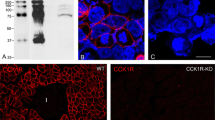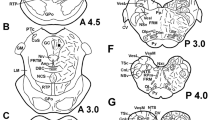Summary
The endocrine pancreas of the desert lizard (Chalcides ocellatus) was investigated histologically and immunocytochemically. The endocrine tissue was concentrated in the dorsal lobe, where it constituted about 7% of the total volume. In the ventral lobe the endocrine tissue formed approximately 1% of the total volume. Four endocrine cell types were observed in the pancreas of this species, namely insulin-, glucagon-, somatostain- and pancreatic polypeptide (PP)-immunoreactive cells. The volume occupied by these cells was 1, 1, 0.6 and 0.3% of the total volume of the pancreas, respectively. Insulin-immunoreactive cells were located in the islet centre and comprised 3% of dorsal and 0.2% of the ventral lobe volume. Glucagon cells occurred at the islet periphery and amounted to 3 and 0.2% of the volume of the dorsal and ventral lobes, respectively. Somatostatin-immunoreactive cells were located at the islet periphery as well as in between the exocrine parenchyma. They constituted 1 and 0.2% of the volume of the dorsal and ventral lobes, respectively. PP-immunoreactive cells occurred mainly among the exocrine parenchyma as solitary cells. They formed only 0.03% of the volume of the dorsal lobe. The corresponding figure in the ventral lobe was 0.6%.
Similar content being viewed by others
References
Bonner-Weir S, Weir GC (1979) The organization of the endocrine pancreas. A hypothetical unifying view of the phylogenetic differences. Gen Comp Endocrinol 38:28–37
Buchan AMJ, Lance V, Polak JM (1982) The endocrine pancreas of Aligator mississippiensis. An immunocytochemical investigation. Cell Tissue Res 224:128
El-Salhy M (1981) On the phylogeny of the gastro-enteropancratic (GEP) neuroendocrine system. Acta Univ Upsal 385:1–39
El-Salhy M, Grimelius L (1981a) Histological and immunohistochemical studies of the endocrine pancreas of lizards. Histochemistry 72:237–247
El-Salhy M, Grimelius L (1981 b) Immunohistochemical localization of gastrin C-terminus, gastric inhibitory peptide (GIP) and endorphin in the pancreas of lizards, with special reference to the hibernation periods. Regul Pept 2:97–111
Erlandsen SL, Parsons JA, Burke JP, Orden DE van, Orden LS van (1975) A modification of the unlabelled antibody enzyme method using heterologous antisera for the light microscopic and ultrastructural localization of insulin, glucagon and growth hormone. J Histochem Cytochem 23:666–677
Grimelius L (1968) A silver nitrate staining for 397-1 in human pancreatic islets. Acta Soc Med Upsal 73:243–270
Rhoten WB, Smith PH (1978) Localization of four polypeptide hormones in the saurian pancreas. Am J Anat 151:595–602
Scott HR (1952) Rapid staining of beta granules in pancreatic islets. Stain Technol 27:267–268
Sternberger LS (1979) Immunocytochemistry. 2nd ed. John Wiley and Sons, New York
Weibel ER (1963) Principles and methods for the morphometric study of the lung and other organs. Lab Invest 12:131–155
Author information
Authors and Affiliations
Rights and permissions
About this article
Cite this article
El-Salhy, M., Abu-Sinna, G. & Wilander, E. The endocrine pancreas of a squamate reptile, the desert lizard (Chalcides ocellatus). Histochemistry 78, 391–397 (1983). https://doi.org/10.1007/BF00496625
Accepted:
Issue Date:
DOI: https://doi.org/10.1007/BF00496625




